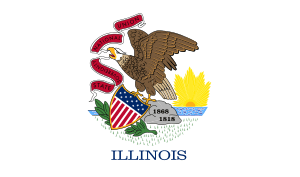Illinois Railway Museum
| Illinois Railway Museum | |
|---|---|
 | |
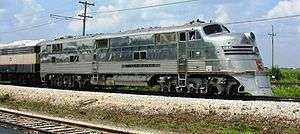 | |
| The only surviving EMD E5 is used regularly on the museum's excursion trains, usually pulling the Nebraska Zephyr. | |
| Locale | Union, McHenry County, Illinois |
| Commercial operations | |
| Built by | Elgin and Belvidere Electric Company |
| Original gauge | 4 ft 8 1⁄2 in (1,435 mm) standard gauge |
| Preserved operations | |
| Reporting mark | IRMX[1][2][nb 1][nb 2] (claimed by the museum) |
| Length | 4.6 mi (7.4 km) |
| Preserved gauge | 4 ft 8 1⁄2 in (1,435 mm) standard gauge |
| Commercial history | |
| Opened | 1906 |
| Closed to passengers | 1930 |
| Closed | 1930 |
| Preservation history | |
| 1953 | Opened as Illinois Electric Railway Museum |
| 1956 |
Elgin and Belvidere Electric right-of-way acquired |
| 1961 | Current name adopted |
| 1964 | Museum relocated |
| 1966 | Illinois Terminal interurban car 415 first operated |
| 1967 | First steam engine operated |
| 1971 | First storage barn erected |
| 1981 | streetcar loop constructed |
| Late1980s / early1990s | Railroad line built |
| Present | Continues open |
| Headquarters | Union, Illinois |
| Website | |
| Illinois Railway Museum | |
The Illinois Railway Museum (initialized IRM, claimed reporting mark IRMX[1][nb 1][nb 2]) is the largest railroad museum in the United States and is located in Union, Illinois, 55 miles (89 km) northwest of Chicago. The museum is situated at 7000 Olson Rd.[3]
The museum was granted its tax-exempt status in 1957 and its mission is to demonstrate the vital role railroads have played in the growth of the Chicago area as well as the United States as a whole. There are over 450 pieces of prototype equipment in its collection as well as numerous displays. Visitors may ride on some of the museum's electric, steam and diesel powered trains from April through October.
Overview
History
The museum was founded in 1953 by ten individuals who joined together to purchase Indiana Railroad interurban car 65.
Originally called the Illinois Electric Railway Museum, the name was changed to IRM in 1961 to reflect the museum's expanding scope. The museum was initially located on the grounds of the Chicago Hardware Foundry in North Chicago, Illinois. In 1964 the museum's entire collection was relocated to Union along the former right-of-way of the Elgin & Belvidere interurban. Two years later, operations were begun using Illinois Terminal interurban car 415, and in 1967 the first steam engine was operated. The first storage barn was erected in 1971. In 1981 a one-mile (1.6 km) streetcar loop was constructed. A 4.6-mile (7.4 km) railroad line was built during the 1980s and early 1990s.
Operations
The museum's operations are primarily concentrated around its main campus just east of Union, Illinois. Train rides are offered on the main line as well as the streetcar loop. Electric trains are operated from April through October, and diesel and steam trains from the beginning of May through the end of September. Trolley bus operation occurs on the Saturdays of the Memorial Day, Independence Day & Labor Day weekends, as well as on "Bus Day", the first Saturday in October. IRM is one of only two railway museums in the country that operates both electric and diesel trains. It is the only museum that offers trolley bus rides.
Equipment and structures
Physical plant
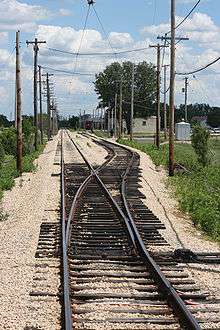
The Illinois Railway Museum has the most extensive physical plant of any rail museum in North America. The main campus is located at 42°13′40.0″N 88°31′38.08″W / 42.227778°N 88.5272444°W. In addition to the museum's revenue trackage, the main campus in Union includes:
- eleven equipment storage barns with a total of about 3 miles (4.8 km) of track under cover
- two additional garages housing trolley buses and motor buses
- a dedicated steam restoration shop
- an 1853 train depot (see below)
- a complete Chicago Rapid Transit Company ground-level station
- four streetcar stations of varying design
- several restored and functional neon signs and concrete entablatures on display
- an indoor dining facility built in 2003
- the 130 foot turnable from the Union Pacific Railroad's Burnham Shops [4]
IRM also owns two off-site libraries, the Pullman Library in downtown Union and the Strahorn Research Library in downtown Marengo.
Notable equipment
Among the equipment preserved at IRM is:
- Conrail GE E33 #4601 Ex Penn Central GE E33 #4601 Exx Virginian GE E33 #132
- Retired Metra F7 locomotive 308.
- one of only two North Shore Line Electroliner trainsets built (under restoration)
- Illinois Central steam locomotive 201 (static display), participated in the "Wheels A-Rolling" pageant at the Chicago Railroad Fair in 1949.
- Nebraska Zephyr
- St. Louis-San Francisco Railway 2-10-0 "Decapod" Frisco 1630 (operational 2013).
- Atchison, Topeka and Santa Fe Railway 4-8-4 "Northern" steam engine 2903
- Norfolk and Western Railway 2-8-8-2 steam locomotive 2050, a 1923 ALCO (Richmond) class Y3a
- Milwaukee Road 4-8-4 "Northern" Engine Number 265. Sister Engine to No. 261
- Milwaukee Road 760, the first diesel locomotive built by Fairbanks Morse in their plant in Beloit, Wisconsin (restored to operating condition)
- Chicago Surface Lines 84, the oldest operational trolley bus in the world
- Chicago and North Western Railway 1518, the first EMD GP7 built
- Chicago and North Western Railway 411, an EMD F7
- Chicago and North Western Railway 6847, an EMD SD40-2 restored from UP. The first SD40-2 donated to a museum
- Grand Trunk Western Railroad Class U-3 4-8-4 6323, the last GTW steam locomotive to run on GTW rails.
- Southern Pacific Railroad 1518, the first EMD SD7 built (operational)
- Union Pacific Railroad 428, a 2-8-0 "Consolidation" (restoration)
- Illinois Central 3719, the only surviving Illinois Central 2-6-0
- Texas & New Orleans/Southern Pacific 975, one of the two surviving Southern Pacific 2-10-2s
- Chicago, Burlington, and Quincy 504, one of the only two SD24s in preservation
- Pennsylvania Railroad 4927, a GG-1
- Chicago, South Shore, & South Bend 803, a 2-D+D-2 the only operational "800 Class"; only run during special occasions
- Union Pacific Railroad 6930 an EMD DDA40X
- Union Pacific Railroad 18, an 8500 hp gas turbine-electric locomotive
- Union Pacific 1848, a B40-8, the second Dash-8 to be preserved.
- Two New York City Transit Authority, IRT Division R28 Series Subway Cars from 1960 #'s 7926-7927 (operational @IRM 17 April 2009), Built by ACF. in the Berwick PA Plant.
- Minneapolis, Northfield and Southern 21, the final Baldwin DT-6-6-2000 road switcher in existence.
- the museum's depot, built in 1851 for the Galena and Chicago Union Railroad, is the oldest train station west of the Appalachian Mountains in regular use
- the museum also maintains an historical collection of 22 electric trolley buses from Chicago, Illinois; Dayton, Ohio; Cleveland, Ohio; Des Moines, Iowa; Vancouver, British Columbia; Edmonton, Alberta; Toronto, Ontario; Milwaukee, Wisconsin; San Francisco, California; Indianapolis, Indiana; and Seattle, Washington.
- Frisco 1630 crossing Olson Rd. in front of the museum
 One of only two surviving examples of Union Pacific's turbines is kept in non-operating condition.
One of only two surviving examples of Union Pacific's turbines is kept in non-operating condition. Milwaukee Road 760, the first locomotive built by Fairbanks-Morse.
Milwaukee Road 760, the first locomotive built by Fairbanks-Morse. Illinois Central Railroad 201, a 2-4-4 at the museum.
Illinois Central Railroad 201, a 2-4-4 at the museum. Green Bay and Western Railroad 2407, an ALCO RSD-15 at the museum.
Green Bay and Western Railroad 2407, an ALCO RSD-15 at the museum.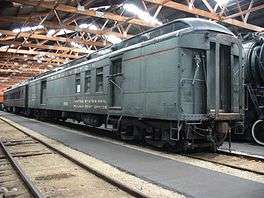 Chicago, Burlington and Quincy Railroad 1926, a Railway Post Office preserved at the museum.
Chicago, Burlington and Quincy Railroad 1926, a Railway Post Office preserved at the museum. Indiana Railroad Interurban operating within the museum.
Indiana Railroad Interurban operating within the museum.- Union Pacific Railroad EMD DDA40X 6930, preserved at the museum.
- Burlington SD24 504, in 2009, after its 7 year long restoration.
 A circa 1907 interurban train operating at the Illinois Railway Museum in 2003
A circa 1907 interurban train operating at the Illinois Railway Museum in 2003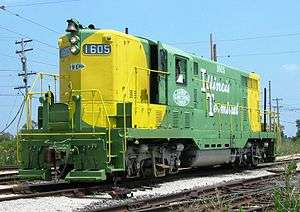 Illinois Terminal Railroad #1605, an EMD GP7, preserved in operational condition within the Illinois Railway Museum.
Illinois Terminal Railroad #1605, an EMD GP7, preserved in operational condition within the Illinois Railway Museum.- CA&E car 431 sits in a barn at the museum
 Chicago Surface Lines car 3142
Chicago Surface Lines car 3142
Organization
The Illinois Railway Museum is an IRS Chapter 501(c)3 nonprofit corporation owned and managed by its membership. Museum management includes a board of directors, elected by the regular membership of approximately 160 active volunteers. A board president is elected by the directors. The board oversees the general manager, a volunteer who in turn has oversight over an array of department heads. Major departments include Steam, Diesel, Electric Car, Passenger Car, Freight Car, Track & Signal, Buildings & Grounds, Trolley Bus, Motor Bus, and Operations. Other departments oversee the museum's libraries, electrical infrastructure, and display and education functions. Most department heads are volunteers. All workers at the museum fall under the direct authority of one of the department heads. The vast majority of workers are volunteers - anyone who is interested in trains or other collections/aspects of the museum is actively encouraged to volunteer, with required training done by the museum.
Use in film
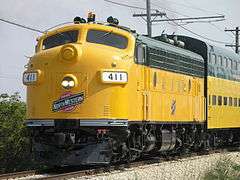
Due to its proximity to Chicago and its extensive collection of historic railroad equipment, IRM has been used in several films. The most apparent may be in the 1992 film A League of Their Own, starring Tom Hanks, Geena Davis and Madonna; the museum's depot was used for several small town depot scenes and the Nebraska Zephyr and only surviving EMD E5 were used for scenes of and on the train. IRM equipment was also seen in the movie Groundhog Day, which featured the museum's EMD SD24 diesel locomotive. Additionally the museum's grounds and some of the passenger cars, were used in the movie The Babe, starring John Goodman. In late 2005, the Burlington 9911A and several coaches operated to Chicago for filming in Flags of Our Fathers, a Clint Eastwood film. The initial sequence of The Express was shot at IRM. The most recent film Transformers: Age of Extinction starring Mark Wahlberg, released in 2014, made IRM the host of several scenes.
Many television shows' railroad sequences have been shot at the IRM. Scenes depicting steam era operations in the late 1920s were shot for the 1993 television series The Untouchables. The hit show Chicago Fire features the IRM onsite in the season 2 episode "No Regrets."
Special events
The museum hosts a series of annual special events, of which the most popular is the Day out with Thomas event in August. Other recurring events include Chicago Day in June, which commemorates the end of streetcar service in Chicago in 1958; the annual July 4th Trolley Pageant; Diesel Days in July; the Vintage Transportation Extravaganza on the first Sunday in August; Museum Showcase Weekend in September; "Bus Day" the first Saturday of October; "Terror on the Railroad" Halloween event (last four weekends of October on Friday and Saturday nights), and "Happy Holiday Railway" (first three weekends of December).
See also
- List of United States railroads
- List of heritage railroads in the United States
- List of railway museums
Notes
- 1 2 Direct sources from the AAR/NMFTA cannot be publicly accessed/located, although such markings have been second-handedly verified via the FRA and visual wise; however, these marks may be considered expired, reassigned, or unofficial as of 2009.
- 1 2 The Illinois Railway Museum has certified that IRMX is their reporting mark, per OTRS ticket 2009103010041944
References
- 1 2 "Illinois Railway Museum: Image". Close-up of reporting marks on official IRM railroad-owned equipment.
- ↑ "Illinois Railway Museum: Image". Equipment photograph bearing IRMX reporting marks.
- ↑ Illinois Railway Museum Contact Address
- ↑ "Illinois Railway Museum buys Burnham Shops turntable". Trains. March 25, 2016. Retrieved March 28, 2016. (subscription required)
External links
|
| |
|
|
| Wikimedia Commons has media related to Illinois Railway Museum. |
Coordinates: 42°13′39″N 88°31′39″W / 42.22763°N 88.52751°W
